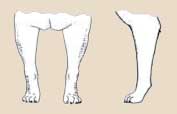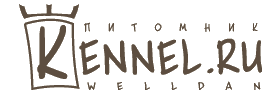Forequarters: Strong bone structure, legs very muscular.
Shoulders: Powerful, prominent muscles. Slant of shoulder-blade medium (about 45o to the horizontal), angle of the scapular-humeral articulation a little more than 90°.
Arms: Very muscular.
Elbows: In the axis of the body, neither too close to the thoracic wall nor turned out.
 Forearms:
Forearms: Viewed from the front, straight or inclining slightly inwards thus getting closer to the median plane, especially in dogs with a very broad chest. Viewed in profile, vertical.
Metacarpial region: Powerful. Viewed in profile, slightly sloping. Viewed from the front sometimes slightly outwards thus compensating for the slight inclination of the forearm inwards.
Feet: Strong. Toes tight, nails curved and strong, pads well developed and supple : the dogue is well up on his toes despite his weight.
Hindquarters: Robust legs with strong bone structure; well angulated. When viewed from behind the hindquarters are parallel and vertical thus giving an impression of power even though the hindquarters are not quite as broad as the forequarters.
 Thigh:
Thigh: Very developed and thick with visible muscles.
Stifle: In a parallel plane to the median plane or slightly out.
Second thigh: Relatively short, muscled, descending low.
Hock: Short, sinewy, angle of the hock joint moderately open.
Metatarsus: Robust, no dewclaws.
Hindfeet: Slightly longer than the front feet, toes tight.
Movement: Quite supple for a molossoid. When walking the movement is free, supple, close to the ground. Good drive from the hindquarters, good extension of the forelegs, especially when trotting, which is the preferred gait. When the trot quickens, the head tends to drop, the topline inclines towards the front, and the front feet get closer to the median plane while striding out with a long reaching movement of the front legs. Short gallop with vertical movement rather important. Capable of great speed over short distances by bolting along close to the ground.
Colour, size, weight
Skin: Thick and sufficiently loose fitting.
Hair: Fine, short and soft to the touch.
Coat: Self-coloured, in all shades of fawn, from mahogany to isabella. A good pigmentation is desirable. Limited white patches are permissible on the chest and the extremities of the limbs.
Mask:
1.
Black mask: The mask is often only slightly spread out and must not invade the cranial region. There may be slight black shading on the skull, ears, neck and top of body. The nose is then black.
2.
Brown mask (used to be called red or bistre): The nose is then brown; the eyerims are also brown.
3.
No mask: The coat is fawn : the skin appears red (also formerly called "red mask"). The nose is then reddish or pink.
Size: Height should more or less correspond to the perimeter of the skull. Males: 60-68 cm at the withers; bitches: 58-66 cm at the withers. 1 cm under and 2 cm over will be tolerated.
Weight: Males: at least 50 kg; Bitches : at least 45 kg.
Bitches: Identical characteristics but less prominent.
